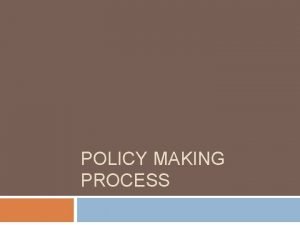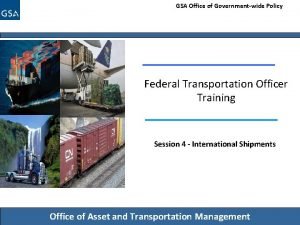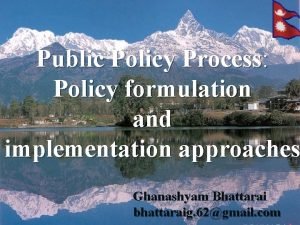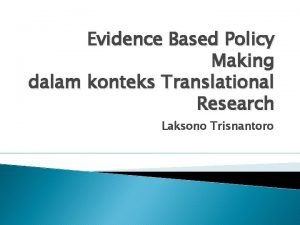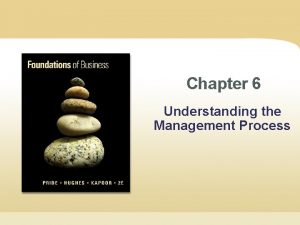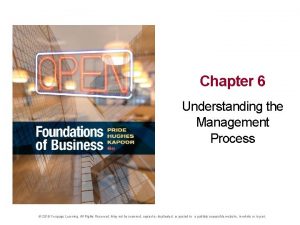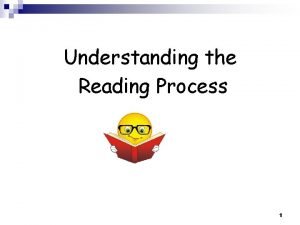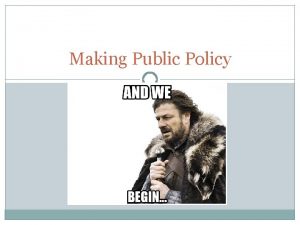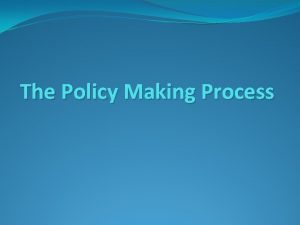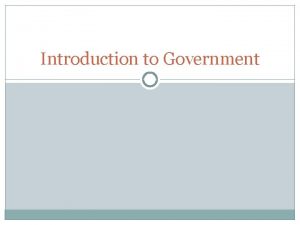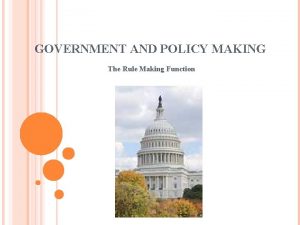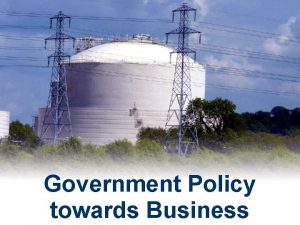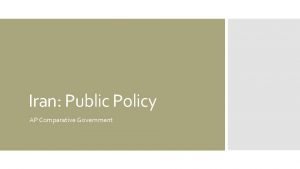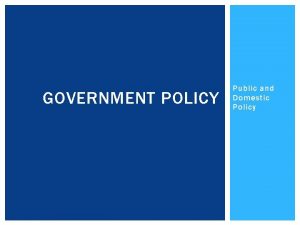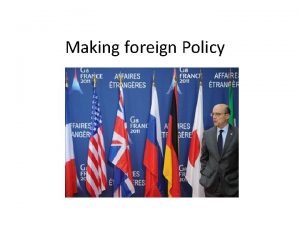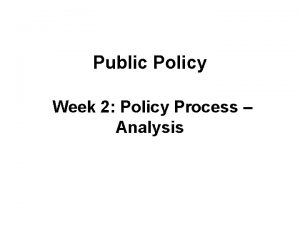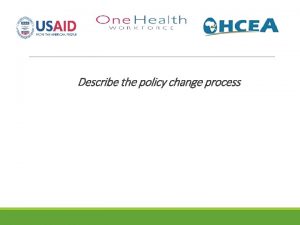The Policy making process 5 1 Understanding Government




















- Slides: 20

The Policy making process 5. 1

Understanding Government • How do people come to believe that certain issues require governmental action? • What explains why some issues are on the political agenda and others are not? • Why are some issues more prominent on today’s agenda than historically, and vice-versa? • Why do elected officials sometimes suddenly shift attention away from some issues and toward others? • What explains timing/character of governmental action or inaction on a given issue?

Public Policy • What is public policy? • Deciding what belongs on the political agenda. • Who sets the agenda? • • Executive Branch Legislative Branch Judicial Branch Constituents • Public Policy is affected by: • • Shared Political values Customs and traditions Impact of events Changes in political elite

The Policy Making process How does an issue get resolved? 1. First has to be identified as a problem 2. Information has to be given to members of Congress (lobbyists typically) 3. Congress has to put the issue on the Political agenda: issues that people believe require governmental action 4. Agenda adoption: choosing a specific strategy from among the proposals that have been discussed (A law or act) 5. Agenda implementation: implement the policy chosen by Congress 6. Agenda evaluation: Groups inside and outside government conduct studies to evaluate and collect “feedback”

Legitimate scope of government 1. 1. 2. Groups: many policies are the result of small groups of people enlarging the scope of government by their demands. Ex. Unions, corporations, People Women’s March, Black Lives Matter, March For Our Lives Changes in values and beliefs of people generally and key politicians are essential part of change of public policy 2. Institutions: The Senate, bureaucracy, and courts are very influential in what goes on the political agenda. 3. Media: the national press can either help place new matters on the agenda or publicize those matters placed there by others 4. The States: Laws that trickle up the Federal government, and State court cases that outcome effects other parts of the nation Government tends to get larger rather than smaller in it’s scope of legitimacy

Making a decision Always have to look at costs and benefits when evaluating a policy Cost: A burden that people believe they must bear if a policy is enacted Benefit: A satisfaction that people believe they will enjoy if a policy is enacted **The perception of costs and benefits is what affects politics. *** ** People also disagree on the benefit, whether the group benefiting has a legitimate right to the benefit. ** Examples: Think of two examples of current public policies and potential public policies and how people perceive the cost and benefit of it.

Making a decision Not only do people take into account who benefits, but they also take into account whether it is legitimate for that group to benefit Ex. Welfare recipients Went from noncontroversial (widows and orphans) to controversial (women with dependent children). ** Issue is people feel that widows are deserving, but not sexually loose women who had never married

Distribution of Costs and Benefits • Majoritarian Politics: A policy in which almost everybody benefits and almost everybody pays. • Arguments tend to be over cost not between rival ideas • Ex. Social Security (hopefully), government sponsored research for cancer and heart disease, or laws to reduce drug use. • Relationship to interest groups: little influence, but instead involve making appeals to the population

Distribution of Costs and Benefits • Interest Group Politics: A policy in which one small group benefits and another small group pays • Concentrated Benefits and Concentrated Costs • Ex. Congress passed a bill requiring companies to give 60 days’ notice of a plant closing or a large scale lay off (notice bill). In this case, Labor Unions benefited and businesses paid the cost. Relationship to interest groups: fought out by organized interest groups and the public is typically uninformed

Distribution of Costs and Benefits • Client Politics: A policy in which one small groups benefits and almost everybody pays. • Concentrated Benefits and Distributed Costs • Those who pay the costs are typically unaware that they are paying. • Ex. Many farmers benefit from agricultural price supports, but many people do not realize that this causes a higher food prices. • Ex. Welfare recipients • Ex. Pork barrel projects: Projects (such as a better harbor, new bridge) that benefit some, but citizens in that area pay for it. • Pork Barrel Legislation: Legislation that gives tangible benefits to constituents in several districts or states in hope of winning their vote in return. • Logrolling: A legislator supports a proposal favored by another in return for support of his or hers

Distribution of Costs and Benefits • Entrepreneurial politics: A policy in which almost everybody benefits and a small groups pays the cost • Distributed Benefits and Concentrated Cost Ex. Brady Bill (background check on gun buyers) and The Antipollution and safety requirements for automobiles (cost fell on the automobile factories) How do these bills get passed? Policy entrepreneurs: Activists in and out of government who pull together a political majority on behalf of unorganized interests (Ralph Nader) Ex: EPA laws the public benefits and businesses who potentially could harm the environment have higher tax burdens or most implement new policies based on the regulations. Ie; Clean water act.

Following Notes go with Hand out PLEASE TAKE NOTICE THAT THERE ARE NO NOTES FOR PAGES 480489 YOU ARE STILL RESPONSIBLE FOR THIS MATERIAL

The Policymaking Process Policy making is when a government decides whether or not to act on a particular problem. ◦ If it chooses to act, the policy making becomes choosing what action to take. Who makes policy? ◦ Executive Branch ◦ Legislative Branch ◦ Courts ◦ Bureaucracy

The Policymaking Process Policy making is when a government decides whether or not to act on a particular problem. ◦ If it chooses to act, the policy making becomes choosing what action to take. Who makes policy? ◦ Executive Branch ◦ Legislative Branch ◦ Courts ◦ Bureaucracy

The Policymaking Process Emergency Economic Stabilization Act of 2008 ◦ Bank bailout bill ◦ Granted treasury secretary (Henry Paulson) power to spend up to $700 billion to support financial institutions

The Policymaking Process Agenda Setting Policy Formulation Policy Adoption Policy Implementation Policy Evaluation

The Policymaking Process Agenda Setting or Problem Identification ◦ An issue comes to the public's attention ◦ Usually brought to attention by the mass media ◦ Interest groups and political parties grow awareness for the issue Policy Formation ◦ The legislature and bureaucracies begin discussing the issue ◦ Many politicians support the policy to gain votes and support ◦ They brainstorm strategies to deal with the problem

The Policymaking Process Policy Adoption ◦ A policy is formally chosen as the solution ◦ Usually, this is in the form of legislation Policy Implementation ◦ Government agencies create procedures, guidance, and grants to support the policy Policy Evaluation ◦ Policy analysts decide whether the policy is effective ◦ The analysts are both government members and outside experts ◦ At this stage, the policy can be revised for optimal success

The Policymaking Process How Do Issues Become Part of an Agenda? Attention from the press Major events (9/11 brought attention to terrorism, defense, security and other important topics) Pressure from the citizens for the government to become involved Debates on Constitutionality The effects of not taking action Is it different from topics already on the agenda?

The Policymaking Agenda Why Are Some Issues are Ignored? Change would negatively effect the powerful and lose support for politicians Issues in the private sector or out of jurisdiction Not enough public support Challenges to tradition or too controversial Temporary issues
 Policymaking process steps
Policymaking process steps The policy making process
The policy making process Fiscal policy meaning
Fiscal policy meaning Office of government wide policy
Office of government wide policy Senior policy officer scottish government
Senior policy officer scottish government What are the three levels of government
What are the three levels of government Steps in policy making
Steps in policy making Evidence based policy making adalah
Evidence based policy making adalah Is making inference simply making a guess
Is making inference simply making a guess War making and state making as organized crime summary
War making and state making as organized crime summary Chapter 6 understanding the management process
Chapter 6 understanding the management process Chapter 6 understanding the management process
Chapter 6 understanding the management process Knowledge process understanding
Knowledge process understanding Language experience approach example
Language experience approach example Hát kết hợp bộ gõ cơ thể
Hát kết hợp bộ gõ cơ thể Bổ thể
Bổ thể Tỉ lệ cơ thể trẻ em
Tỉ lệ cơ thể trẻ em Gấu đi như thế nào
Gấu đi như thế nào Tư thế worms-breton
Tư thế worms-breton Chúa sống lại
Chúa sống lại
